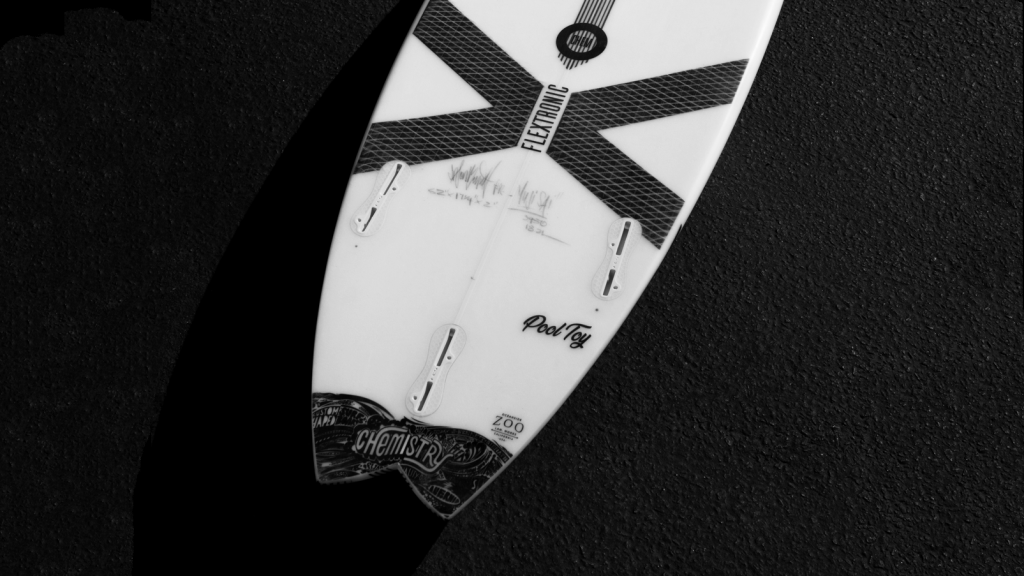Know your rocker: Cheyne Magnusson’s Pool Toy model

Surfboard design theory as it applies to wave pools is more complicated than it seems. Yes, we can use Computational Fluid Dynamics to test water flow around different tail shapes and apply it to repeated wave pool sessions. Or, we just rely on the world’s best shapers, like Matt Biolos and Christiaan Bradley, to flow with ideas and concepts.
There are also companies like Cush Surfboards who are experimenting with an epoxy semi-soft build to suit the hard-hitting nature of wave pools.
We are the dawn of wave pool-specific craft. And in some cases, that means on a specific spot, like BSR Surf Resort.
One model built and tested specifically for PerfectSwell tech at BSR is Chemistry Surfboards’ Pool Toy. Shaper Jason Bennett worked with BSR Surf Resort manager Cheyne Magnusson to come up with the design.

“When I was managing BSR I thought it could be so cool to have a board designed specifically for the wave,” says Magnusson. “So we had Jason Bennett come surf with us for a few days and really get to know the wave inside and out. He came up with a board that has a good amount of tail rocker and is thinner than what I imagined being optimum for freshwater.”
But even in this world of empirical data and veteran board builders, the wave pool world can throw a design curve. We’ve studied the buoyancy issue in unsalted wave pools and have some science backing to explain why surfboards are less floaty in artificial waves. But this isn’t always the case.
“We came up with the idea after surfing the pool at BSR and using equipment that we thought would work well from preconceived notions of surfing freshwater man-made waves,” says Eric Warner of Chemistry. “We were hearing that the freshwater was less buoyant and the man-made waves did not pack the punch of the ocean. To our surprise, the technology that BSR uses creates a wave that is not only powerful but makes the lack of freshwater buoyancy, not an issue.”

So Bennett took one of Chemistry’s most popular models and made some subtle tweaks, mostly to volume and rocker. Traditionally, rocker helps boards fit in tight places.
“Rocker was added in the right places and surface area was removed where it wasn’t needed,” adds Warner. “In such a tight curved wave with that much power, it’s mainly about being able to maintain control and fitting in the curve of the wave.”
Magnussen got to try the design in repeated BSR sessions and agrees.
“BSR is really bowled out so the extra tail rocker allows tight quick turns in the pocket so you get more turns in than a standard shortboard if you stay in the pocket.”
One of the biggest differences in the Pool Toy compared to salted craft is thinner volume overall. Too much foam and a board won’t cut through the water. A thick rail and lots of volume under the nose will get push back from where it contacts with the water. So rather than slicing through a section of the wave, it floats around it.
This works great in a beginner board or a longboard where one wants stability. But not in a high-performance wave pool surfboard. And since one doesn’t need too paddle the board a quarter-mile to an outside break, or reposition in heavy currents, the shaper can cut down on the paddle volume.
“We eliminated the surface area usually needed for paddle power and speed generation (through slow sections,) therefore also enhancing its rail-to-rail maneuverability and pocket control,” adds Warner.
So while there are other minor tweaks to the design (controlled flex carbon strip construction), the biggest takeaway is the enhanced rocker and diminished volume.
Chemistry says that as they sample more wave pool technologies, revisions to the existing model will be made. Cheyne adds that the wave pool board design frontier is totally open at this point.
“It’s going to be cool to see the different board designs that come out as new and different wave parks open up!”
Trackback from your site.
Related Coverage

Full update on Oceanside's wave pool... – Wave Pool Magazine - For your curiosity and stoke
| #
[…] Smith of Chemistry Surfboards, the makers of Cheyne Magnusson’s Pool Toy model, expressed concerns about the development in the San Diego Reader article. “They call it a surf […]
on this reddit website
| #
on this reddit website
Wave Pool Board Designs: Chemistry’s Pool Toy model
cigaleinfos.com
| #
cigaleinfos.com
Wave Pool Board Designs: Chemistry’s Pool Toy model